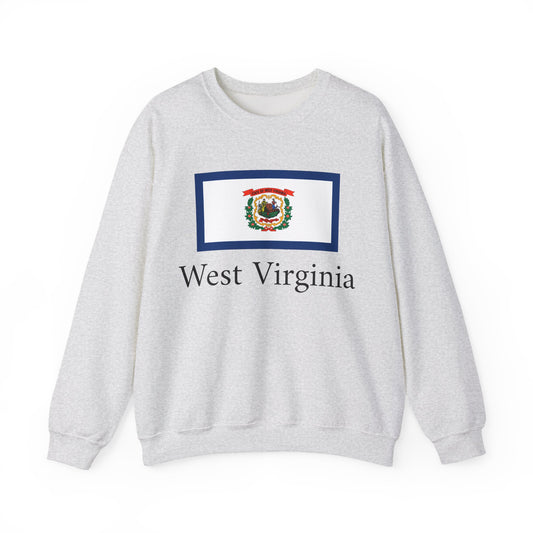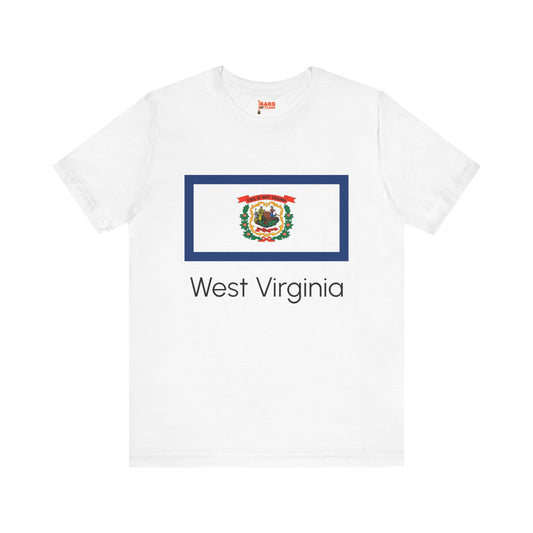-
West Virginia Backpack
Regular price $59.79 USDRegular priceUnit price / per -
West Virginia Mug
Regular price $11.65 USDRegular priceUnit price / per -
West Virginia Pillow
Regular price $22.65 USDRegular priceUnit price / per -
West Virginia Trucker Cap
Regular price $14.90 USDRegular priceUnit price / per -
West Virginia Sweatshirt
Regular price $34.15 USDRegular priceUnit price / per -
West Virginia Flag Sweatshirt
Regular price $34.15 USDRegular priceUnit price / per -
West Virginia Hoodies
Regular price $34.40 USDRegular priceUnit price / per -
West Virginia Flag Hoodies
Regular price $34.40 USDRegular priceUnit price / per -
West Virginia T-shirts
Regular price $22.79 USDRegular priceUnit price / per -
West Virginia Flag T-shirts
Regular price $22.79 USDRegular priceUnit price / per
Collection: US State: West Virginia WV flag
The West Virginia flag, a symbol of pride and heritage for the people of the Mountain State, has a rich history and deep symbolism. We will explore the design, historical context, symbolism, current relevance, and intriguing facts about the flag of West Virginia.
Overview of the West Virginia Flag

Its unique design and striking colors distinguish the flag of West Virginia. A white field encased within a dark blue border frames the state's coat of arms, showcasing the essence of West Virginia’s heritage and values. At the center of the flag, the coat of arms is highlighted, featuring the figures of a miner and a farmer standing on either side of a rock, inscribed on the date of West Virginia's admission to the Union, June 20, 1863. Above this, a red Phrygian cap, a symbol of liberty, sits atop a rifle, illustrating the state's fight for freedom.
A pair of rifles encircled by a laurel wreath, signifying peace and victory, surrounds the lower part of the rock. The imagery is rich with the narrative of labor, struggle, and the triumph of independence, symbolized further by the red ribbon below, proclaiming West Virginia's motto. This ensemble serves as a reminder of the state’s origins and the resilience of its people and as a celebration of its ongoing commitment to liberty and hard work.
Historical Context of the West Virginia Flag
The journey of the West Virginia flag to its current form began in the early 20th century. Having seceded from Virginia during the tumultuous years of the Civil War, the state was admitted to the Union in 1863. It was not until 1929, however, the flag as we know it today was officially adopted. This period was characterized by West Virginia’s endeavor to forge a distinct identity, distancing itself from its Confederate past and aligning more closely with the values of the Union.
The flag, designed by Charles Hamlin, reflects this aspiration through its symbols and colors, embodying the state's pride in its heritage and its commitment to progress and unity. Over the years, the flag has undergone minor changes. Still, its core elements, which capture the spirit of West Virginia's independence and its roots in agriculture and industry, have remained consistent. This adoption and the ensuing modifications highlight a significant chapter in the state's history, marking its growth and the evolution of its identity.
Symbolism Embodied in the Flag
The symbolism within the West Virginia flag is deeply ingrained in its design and colors, each element telling a part of the state’s story. The dark blue border encapsulates the flag, symbolizing the Union and the loyalty of West Virginia to it during the tumultuous period of the Civil War. This is juxtaposed with the pure, white field in the center, representing the integrity and virtue of the state's citizens.
At the heart of the flag lies the coat of arms, a detailed and complex symbol of West Virginia’s identity. The miner and the farmer depict the state’s foundational industries—coal mining and agriculture—highlighting the hardworking nature of its people. The rock bearing the state’s admission date signifies the steadfastness and resilience of West Virginians in their quest for statehood. Above it, the red Phrygian cap on a rifle stands as a beacon of liberty and the fight for freedom, a central theme in the state's formation. Surrounding this scene, two rifles encased in a laurel wreath denote the readiness to defend freedom, peace, and victory, suggesting that out of conflict comes tranquility.
Completing this rich tapestry of symbols, the red ribbon unfurls with the state motto, a final nod to the values of independence and perseverance that run deep in West Virginia's spirit. Through these symbols, the flag narrates the enduring tale of a state forged from the turmoil of civil strife into a bastion of liberty and hard labor.
Current Relevance of the West Virginia Flag
Today, the West Virginia flag holds a prominent place in state and national life, symbolizing its people's enduring values and spirit. Its presence is felt at a broad array of functions, from governmental proceedings to public schools, where it serves as a constant reminder of the state’s rich history and traditions. The flag is praised during military ceremonies, reflecting West Virginia's respect for those who have served and sacrificed. The flag also appears during significant national and state celebrations, where it waves as a symbol of unity and pride.
Despite its widespread use and respect, the flag has sparked conversations around its symbols and the stories it represents. Debates have emerged, focusing on the nuances of history, representation, and the evolving understanding of heritage. These discussions are a testament to the flag’s living relevance, showing that it is more than just a symbol; it is a canvas for the ongoing dialogue about West Virginia's past, present, and future.
Additional Facts and Protocols for the West Virginia Flag
Handling and displaying the West Virginia flag is governed by a set of thoughtful protocols that ensure its dignity is maintained at all times. When flown alongside other flags, the West Virginia flag must take a position of prominence, ideally above the rest. In indoor settings, it earns the place of honor to the observer's left when facing the display. During flag ceremonies, care must be taken to ensure that it is raised briskly and lowered ceremoniously, reflecting the respect and esteem in which it is held. Notably, the flag should never touch the ground or be used in any manner that could be construed as disrespectful.
An interesting tidbit about the flag involves its specific dimensions and proportions, which are dictated by law, ensuring uniformity across all representations. Furthermore, the flag features a unique distinction not commonly known: the floral wreath encompassing the state's coat of arms is composed of rhododendron, the state flower, symbolizing the natural beauty and resilience of West Virginia. This careful attention to detail in both the flag's design and its protocols underscores the deep reverence for state symbols and the values they embody.




















